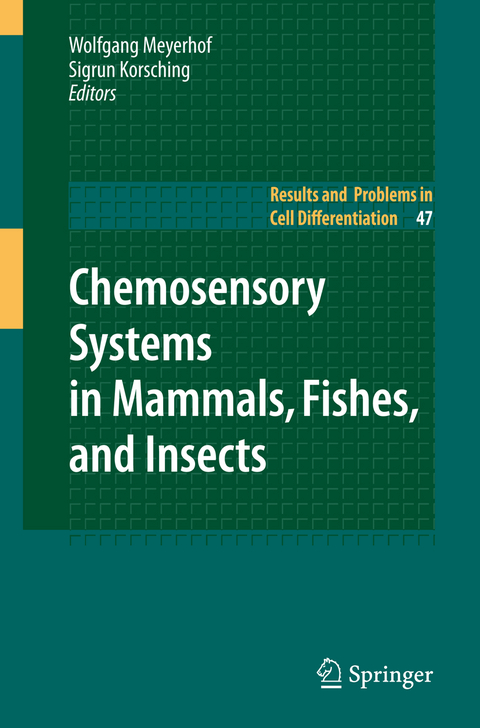
Chemosensory Systems in Mammals, Fishes, and Insects
Seiten
2010
|
1. Softcover reprint of hardcover 1st ed. 2009
Springer Berlin (Verlag)
978-3-642-08939-8 (ISBN)
Springer Berlin (Verlag)
978-3-642-08939-8 (ISBN)
The 12 chapters here cover our current knowledge of the chemosensory systems in mammalian, fish and insect models. The advantages of each system are analyzed, as are the genomic characteristics and evolution of olfactory and gustatory receptor gene families.
The sense of smell has an essential role in locating food, detecting predators, navigating, and communicating social information. Accordingly, the olfactory system has evolved complex repertoires of receptors to face these problems. Although the sense of taste has less far-reaching tasks, they are every bit as essential for the animals well-being, allowing it to reject toxic materials and to select nutritionally valuable food. The last decade has seen a massive advance in understanding the molecular logic of chemosensory information processing, beyond that already achieved in the rst few years following Linda Bucks discovery of odorant receptors. Shortly afterwards, the major principles of olfactory representation had been established in mammals as the one neuron/ one receptor rule and the convergence of neurons, which express the same receptor, onto individual modules in the olfactory bulb. In recent years, such studies have been extended to lower vertebrates, including shes and other phyla, i. e. , arthropods, worms, and insects, showing both the general validity of these concepts and some exceptions to the rule. In parallel, hallmarks of the molecular logic of taste sensation have been deciphered and found to differ in interesting ways from those of smell sensation.
The sense of smell has an essential role in locating food, detecting predators, navigating, and communicating social information. Accordingly, the olfactory system has evolved complex repertoires of receptors to face these problems. Although the sense of taste has less far-reaching tasks, they are every bit as essential for the animals well-being, allowing it to reject toxic materials and to select nutritionally valuable food. The last decade has seen a massive advance in understanding the molecular logic of chemosensory information processing, beyond that already achieved in the rst few years following Linda Bucks discovery of odorant receptors. Shortly afterwards, the major principles of olfactory representation had been established in mammals as the one neuron/ one receptor rule and the convergence of neurons, which express the same receptor, onto individual modules in the olfactory bulb. In recent years, such studies have been extended to lower vertebrates, including shes and other phyla, i. e. , arthropods, worms, and insects, showing both the general validity of these concepts and some exceptions to the rule. In parallel, hallmarks of the molecular logic of taste sensation have been deciphered and found to differ in interesting ways from those of smell sensation.
Molecular Genetic Dissection of the Zebrafish Olfactory System.- The Receptor Basis of Sweet Taste in Mammals.- Odorant Receptor Gene Choice and Axonal Projection in the Mouse Olfactory System.- Extraordinary Diversity of Chemosensory Receptor Gene Repertoires Among Vertebrates.- Mammalian Bitter Taste Perception.- Gustation in Fish: Search for Prototype of Taste Perception.- Orosensory Perception of Dietary Lipids in Mammals.- Pheromone Sensing in Mice.- Smelling, Tasting, Learning: Drosophila as a Study Case.- Insect Olfaction: Receptors, Signal Transduction, and Behavior.- The Molecular Evolution of Teleost Olfactory Receptor Gene Families.- Genomics of Olfactory Receptors.
| Erscheint lt. Verlag | 19.10.2010 |
|---|---|
| Reihe/Serie | Results and Problems in Cell Differentiation |
| Zusatzinfo | XVIII, 262 p. 46 illus., 25 illus. in color. |
| Verlagsort | Berlin |
| Sprache | englisch |
| Maße | 155 x 235 mm |
| Gewicht | 422 g |
| Themenwelt | Naturwissenschaften ► Biologie ► Biochemie |
| Naturwissenschaften ► Biologie ► Humanbiologie | |
| Naturwissenschaften ► Biologie ► Zoologie | |
| Schlagworte | Behavior • Mammalia • Olfaction • perception • Predator • receptor • Taste • Transduction |
| ISBN-10 | 3-642-08939-9 / 3642089399 |
| ISBN-13 | 978-3-642-08939-8 / 9783642089398 |
| Zustand | Neuware |
| Haben Sie eine Frage zum Produkt? |
Mehr entdecken
aus dem Bereich
aus dem Bereich


